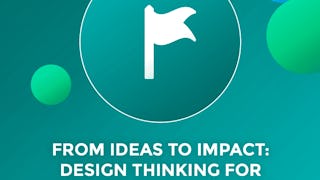Today innovation is everyone's business. Whether you are a manager in a global corporation, an entrepreneur starting up, in a government role, or a teacher in an elementary school, everyone is expected to get lean – to do better with less. And that is why we all need design thinking. At every level in every kind of organization, design thinking provides the tools you need to become an innovative thinker and uncover creative opportunities that are there – you're just not seeing them yet.

Enjoy unlimited growth with a year of Coursera Plus for $199 (regularly $399). Save now.

Design Thinking for Innovation
This course is part of Leading the Modern Day Business Specialization

Instructor: Jeanne M. Liedtka
468,752 already enrolled
Included with
(9,147 reviews)
Recommended experience
What you'll learn
What design thinking is and when to use it
How to prepare to see and take action when opportunity arises
How to use design thinking to generate innovative ideas
How to take the many ideas you generate and determine which ones are likely to produce specific, desired outcomes
Skills you'll gain
Details to know

Add to your LinkedIn profile
See how employees at top companies are mastering in-demand skills

Build your subject-matter expertise
- Learn new concepts from industry experts
- Gain a foundational understanding of a subject or tool
- Develop job-relevant skills with hands-on projects
- Earn a shareable career certificate

There are 5 modules in this course
Welcome to the course -- we're excited you're here! We will begin by unpacking what we mean by design thinking and why it is more effective than traditional methods when the goal is innovation. By looking at the case history of The Good Kitchen, a Denmark program for providing meals for the elderly, we will explore how the mindset and practice of the innovation team that partnered with innovation consultant Hatch & Bloom enabled them to achieve innovation and growth. We’ll also examine what kinds of challenges are best-suited for design thinking and learn about the Visualization tool, which helps bring ideas to life. By the end of this module, you'll have a better understanding of what we mean by design thinking, when to use it, and how to use the Visualization tool.
What's included
6 videos2 readings
Design thinking is not only about process and tools, it is about people as well: about you as a design thinker and about the people you want to create value for and with. And so, before we jump into the process of using design thinking to generate and test ideas, we want to first focus on your mindset, and look at whether your mind is prepared to both see and act on opportunity when it shows up in your world. We will examine this issue by looking at the stories of two very capable managers, George and Geoff, and how their differing mindsets affect their ability to lead innovation and growth. We'll also learn about the value of the Storytelling tool. By the end of this module, you'll have a better understanding of a mind prepared to see and take action when opportunity arises, and how to use the Storytelling tool.
What's included
4 videos
Now we will dive deeper into the design thinking process, looking at how we can use it to generate better ideas. In this module, we will look at the story of an entrepreneur, Chris Cartter, and his start-up, MeYouHealth, as they worked with Boston design firm, Essential Design, to understand the kind of opportunity that social networking might hold for helping us to improve our health. Examining what already exists is the first step in the design thinking process. As part of assessing "what is?", designers “follow the customer home” and explore the problems they are trying to solve in life versus their product use. Once they have thoroughly explored and looked for patterns, designers look toward the future and ask "what if?" This is the creative part of the process, but it also requires a disciplined approach. By the end of this module, you'll understand how to use design thinking to generate innovative ideas, how to apply the "what is?" and "what if?" questions, and how to use the Mind Mapping tool.
What's included
4 videos
Having generated all of these innovative ideas, what’s next? The design thinking process now helps us to take the many ideas we have generated and figure out how to determine which ones are likely to produce the specific kinds of outcomes we want, whether these take the form of improved nutrition for the elderly (e.g., The Good Kitchen), healthier lifestyle choices (e.g., MeYouHealth) or even more “hot leads” emanating from your trade shows (as in the IBM example to follow). In this module, we will follow the activities of an IBM team working closely with experience marketing agency George P. Johnson as they develop and test ideas for a revolutionary approach to trade show participation. This process begins by asking "what wows?". This question brings together the customer and business cases supporting our new concepts. Typically, the “wow” zone occurs at the intersection of three criteria: 1) somebody wants it, 2) we can create and deliver it, and 3) doing so has the potential to produce the outcomes we want. Then we ask "what works?" and conduct small experiments to test if our assumptions are accurate. By the end of this module, you'll understand how to apply the "what wows?" and "what works?" questions, and how to use the Learning Launch tool. We'll conclude by reviewing our lessons and discussing strategic opportunities.
What's included
5 videos
This module hosts materials related to your final assignment for the course. The assignment requires selecting one of the design thinking tools presented in the course, writing a reflection, and completing three peer reviews. To successfully complete the course, you must complete and pass the final assignment.
What's included
1 reading1 assignment1 peer review
Earn a career certificate
Add this credential to your LinkedIn profile, resume, or CV. Share it on social media and in your performance review.
Instructor

Offered by
Explore more from Business Strategy
 Status: Free Trial
Status: Free TrialCoursera
 Status: Free Trial
Status: Free TrialUniversity of Virginia
 Status: Preview
Status: PreviewUniversity of Virginia
 Status: Preview
Status: PreviewIE Business School
Why people choose Coursera for their career




Learner reviews
9,147 reviews
- 5 stars
74.75%
- 4 stars
20.01%
- 3 stars
3.52%
- 2 stars
0.95%
- 1 star
0.74%
Showing 3 of 9147
Reviewed on Jun 13, 2017
Good and easy to understand course. Design Thinking is a key methodology in Business nowadays. This course presents the key concepts and introduces you to the methodology through easy going lectures.
Reviewed on Sep 24, 2019
Good Course ! I liked the way instructor has provided the instructions along with the presentation. The only reason why It's 4 start, that I was looking for some training material to download :)
Reviewed on Aug 15, 2020
Excellent program to learn lots of tools towards Design Thinking !! Thanks a lot! Very interactive and the last activity of completing the assignment was very thought provoking !! thanks to all pears!

Open new doors with Coursera Plus
Unlimited access to 10,000+ world-class courses, hands-on projects, and job-ready certificate programs - all included in your subscription
Advance your career with an online degree
Earn a degree from world-class universities - 100% online
Join over 3,400 global companies that choose Coursera for Business
Upskill your employees to excel in the digital economy
Frequently asked questions
To access the course materials, assignments and to earn a Certificate, you will need to purchase the Certificate experience when you enroll in a course. You can try a Free Trial instead, or apply for Financial Aid. The course may offer 'Full Course, No Certificate' instead. This option lets you see all course materials, submit required assessments, and get a final grade. This also means that you will not be able to purchase a Certificate experience.
When you enroll in the course, you get access to all of the courses in the Specialization, and you earn a certificate when you complete the work. Your electronic Certificate will be added to your Accomplishments page - from there, you can print your Certificate or add it to your LinkedIn profile.
Yes. In select learning programs, you can apply for financial aid or a scholarship if you can’t afford the enrollment fee. If fin aid or scholarship is available for your learning program selection, you’ll find a link to apply on the description page.
More questions
Financial aid available,
¹ Some assignments in this course are AI-graded. For these assignments, your data will be used in accordance with Coursera's Privacy Notice.

